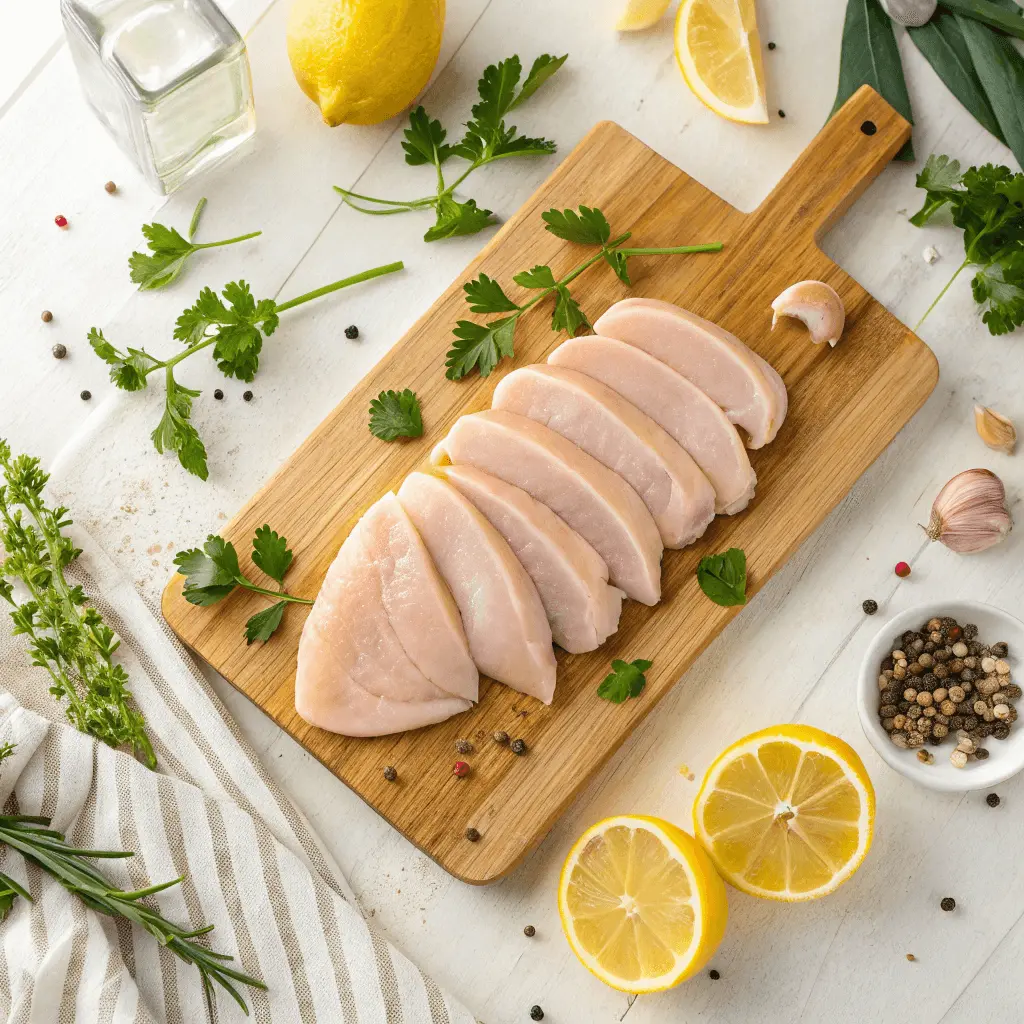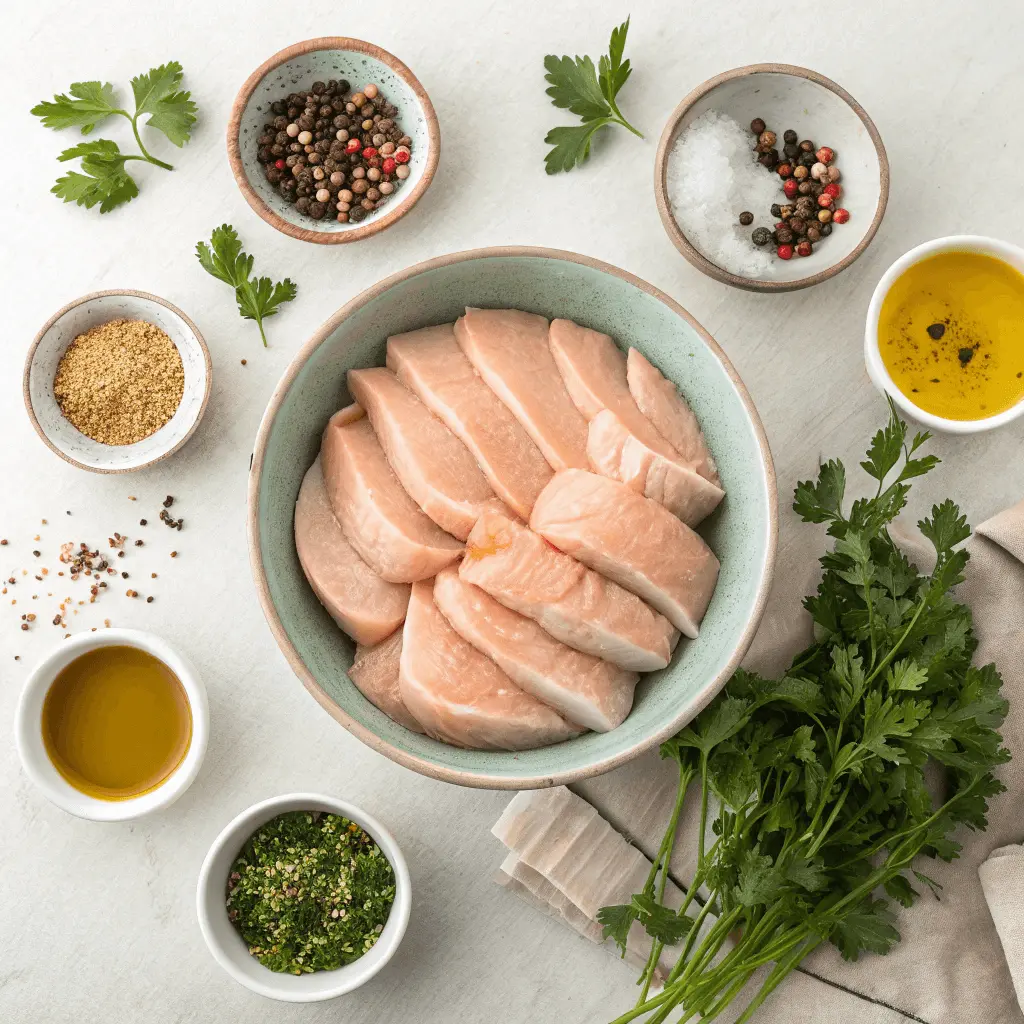Thin sliced chicken breasts have saved dinner in my house more times than I can count. Picture this: it’s 6 p.m., everyone’s hungry, and you need to get a meal on the table—fast. You open the fridge, spot that pack of thin sliced chicken breasts, and know you’re in business. Whether you’re pan-frying them in minutes, layering them into a cheesy baked dish, or tossing them on the grill, these thin cuts are the ultimate mealtime hero.
What makes thin sliced chicken breasts so popular? It’s their versatility and speed. Unlike thick chicken breasts that take ages to cook and risk drying out, thin sliced pieces are ready in a flash and soak up marinades beautifully. They’re perfect for busy weeknights, meal prep Sundays, or when you want to impress with a dish that looks fancy but takes minimal effort.
In this complete guide, we’ll cover everything you need to know—from how to slice them yourself at home to the best cooking methods, flavorful marinades, and expert safety tips. Whether you’re a seasoned home cook or just starting out, thin sliced chicken breasts are about to become your new favorite ingredient.
Table of Contents
What Are Thin Sliced Chicken Breasts? (Everything You Need to Know)

Definition and Key Features of Thin Sliced Chicken Breasts
Thin sliced chicken breasts are boneless, skinless chicken breasts that have been cut horizontally into thinner pieces, usually between ¼ to ½ inch thick. This cut is designed to cook quickly and evenly, making it ideal for fast, healthy meals.
Here’s a quick look at their key features:
| Feature | Details |
|---|---|
| Thickness | Around ¼ to ½ inch thick |
| Cooking Time | Very fast (2–5 minutes per side, depending on method) |
| Best For | Grilling, baking, frying, stir-fries |
| Marinade Absorption | High—flavors soak in quickly |
| Texture | Tender and juicy when cooked properly |
Because of their thinness, these chicken breasts are perfect for busy cooks. They’re especially popular in recipes where keeping the chicken moist and flavorful is key.
For a delicious way to use them in a meal, check out this Alice Springs Chicken recipe—a perfect example of how versatile thin sliced chicken can be.
Thin Sliced Chicken Breasts vs. Regular Chicken Cutlets: What’s the Difference?
It’s easy to mix up thin sliced chicken breasts with chicken cutlets, but they’re not exactly the same. Here’s a simple breakdown:
- Thin sliced chicken breasts:
- Made by slicing a whole breast horizontally.
- Thinner than regular breasts but still hold some thickness.
- Ideal for grilling, baking, or pan-frying without pounding.
- Chicken cutlets:
- Start as thin slices but are then pounded even thinner (around ⅛ inch).
- Cook super fast, often used for dishes like schnitzel or chicken piccata.
- More delicate texture; great for quick searing or breading.
In short: thin sliced chicken breasts are slightly thicker and juicier, while cutlets are extra thin and tender.
For a deeper dive into the differences, don’t miss this guide on thin sliced chicken breasts vs. chicken cutlets.
Best Uses for Thin Sliced Chicken in Everyday Cooking
Thin sliced chicken breasts are a kitchen staple because they cook fast and fit into many meals. Here are some of the best ways to use them:
Quick Meal Ideas:
- Stir-fries: Add thin sliced chicken for fast, flavorful dinners.
- Grilled sandwiches: Perfect size for paninis and wraps.
- Oven-baked favorites: Try them in casseroles or baked Parmesan.
- Salads: Slice up grilled breasts for protein-packed salads.
Why Cooks Love Them:
- Save time on busy nights.
- Cook evenly with less risk of drying out.
- Versatile across many cuisines and cooking methods.
With their tender texture and quick cooking time, thin sliced chicken breasts are a smart choice for fast, nutritious meals that don’t skimp on flavor.
How to Prepare Thin Sliced Chicken Breasts at Home

Essential Tools for Slicing Chicken Breasts Thin
Before you start slicing, make sure you have the right tools. Using proper equipment ensures your thin sliced chicken breasts are cut evenly and safely.
Here’s what you need:
- Sharp chef’s knife: A well-sharpened blade makes clean cuts and reduces the risk of tearing the meat.
- Cutting board: A sturdy, non-slip board keeps everything stable.
- Kitchen gloves (optional): Helps maintain hygiene when handling raw chicken.
- Plastic wrap or freezer bags: Useful if you want to pound the slices after cutting for extra thinness.
- Kitchen ruler (optional): To check the thickness of your slices for consistency.
Tip: Chill the chicken breasts in the freezer for 15 to 20 minutes before slicing. Slightly firm meat is easier to cut evenly.
Pro Method: How to Slice Chicken Breasts Thinly and Evenly
Follow these simple steps to slice chicken breasts perfectly at home.
Step 1: Prep the Chicken
Pat the chicken breasts dry with paper towels to remove excess moisture. This prevents slipping while cutting.
Step 2: Position the Chicken
Lay the breast flat on your cutting board. If the breast is uneven, press it gently with your palm to flatten it slightly.
Step 3: Slice Carefully
Hold your knife parallel to the cutting board. Start at the thicker side and slowly slice the breast in half horizontally. Use smooth, steady movements for best results.
Step 4: Check Thickness
Aim for slices about ¼ to ½ inch thick. If needed, cover them with plastic wrap and gently pound them with a meat mallet to even out the thickness.
Bonus Tip: Always slice against the grain to ensure the chicken stays tender when cooked.
Expert Tips for Storing Prepped Thin Sliced Chicken
Proper storage keeps your thin sliced chicken breasts fresh and safe to eat. Here’s a quick guide:
| Storage Method | Instructions | Shelf Life |
|---|---|---|
| Refrigeration | Store in airtight containers or sealed bags. | Up to 2 days |
| Freezing (Raw) | Place slices between parchment paper in freezer-safe bags. | Up to 3 months |
| Freezing (Marinated) | Freeze directly in marinade in sealed bags. | Up to 2 months |
Extra Tips:
- Label containers with the date to keep track of freshness.
- Squeeze out as much air as possible before freezing to prevent freezer burn.
- Thaw frozen thin sliced chicken breasts in the refrigerator overnight for best results.
With these simple steps and tips, you’ll have perfectly prepped chicken breasts ready whenever you need them, saving time on busy days.
Top Cooking Techniques for Thin Sliced Chicken Breasts (Quick & Juicy Methods)

Quick Pan-Frying for Busy Weeknights
Pan-frying is one of the easiest and fastest ways to cook thin sliced chicken breasts. It’s perfect for busy weeknights when you need a meal on the table fast.
Steps for Perfect Pan-Frying:
- Heat a non-stick skillet over medium-high heat and add a tablespoon of oil.
- Season the thin sliced chicken breasts with salt, pepper, and your favorite spices.
- Once the oil is hot, add the chicken slices in a single layer.
- Cook for 2 to 3 minutes on each side until golden brown and cooked through.
- Remove from the pan and let rest for a few minutes before serving.
Tips for Success:
- Do not overcrowd the pan; cook in batches if needed.
- Use a meat thermometer to ensure the internal temperature reaches 165°F (74°C).
- For extra flavor, deglaze the pan with a splash of lemon juice or chicken broth after cooking.
Pan-frying delivers juicy, flavorful chicken in under 10 minutes.
Baking Thin Sliced Chicken Breasts Without Drying Out
Baking is a healthier cooking option but can easily dry out thin sliced chicken breasts if not done right. Here’s how to keep them moist and tender.
Oven-Baking Guide:
- Preheat your oven to 400°F (200°C).
- Arrange the chicken slices in a single layer on a baking sheet lined with parchment paper.
- Brush lightly with olive oil and season generously.
- Cover the tray with foil to lock in moisture.
- Bake for 12 to 15 minutes, checking for doneness at around 10 minutes.
Additional Tips:
- Add a marinade or sauce before baking for extra juiciness.
- Let the chicken rest for 5 minutes after baking to retain its juices.
- Avoid overcooking; thin sliced chicken breasts cook quickly.
Baking gives you hands-free cooking while keeping your chicken juicy and tender.
Want to get started? Learn the best way to bake thin sliced chicken breasts at 350°F to keep them juicy and tender.
Grilling & Air Fryer Tips for Crisp, Flavorful Chicken
Grilling and air frying are excellent for creating a crisp exterior while keeping the inside juicy. Both methods work well for thin sliced chicken breasts.
Grilling Tips:
- Preheat the grill to medium-high.
- Oil the grates to prevent sticking.
- Grill chicken slices for 2 to 3 minutes per side until well-marked and cooked through.
- Baste with marinade or sauce during grilling for added flavor.
Air Fryer Tips:
- Preheat the air fryer to 375°F (190°C).
- Lightly coat chicken with oil spray and season.
- Cook for 8 to 10 minutes, flipping halfway through.
Both methods give you flavorful, crisp results without much effort.
Master the essentials with this step-by-step guide to cooking thin sliced chicken breasts perfectly.
Best Marinades, Seasonings & Flavor Combos for Thin Sliced Chicken Breasts

Top 5 Easy Marinades for Juicy Chicken
Marinating thin sliced chicken breasts is one of the best ways to add flavor and keep the meat moist. Thanks to their thinness, these chicken breasts absorb marinades quickly—often in just 30 minutes.
Here are five simple and delicious marinades to try:
- Lemon Herb Marinade
- Olive oil, lemon juice, minced garlic, dried oregano, and parsley.
- Honey Mustard Marinade
- Dijon mustard, honey, apple cider vinegar, and a pinch of paprika.
- Garlic Soy Marinade
- Soy sauce, minced garlic, sesame oil, and a dash of ground black pepper.
- Spicy Buffalo Marinade
- Hot sauce, melted butter, garlic powder, and cayenne pepper.
- Mediterranean Marinade
- Olive oil, red wine vinegar, crushed garlic, rosemary, and thyme.
For best results, marinate the chicken for at least 30 minutes and up to 2 hours in the refrigerator.
Healthy Seasoning Ideas (Low-Sodium & Keto-Friendly)
If you’re looking to keep things simple and healthy, dry seasonings are a fantastic option. They add big flavor without extra calories or carbs—great for low-sodium and keto diets.
Seasoning Ideas:
- Garlic powder and smoked paprika for a smoky kick.
- Lemon zest and black pepper for a fresh, zesty taste.
- Italian seasoning mix with dried basil, oregano, and thyme.
- Chili flakes and cumin for a mild heat.
- Fresh herbs like rosemary, parsley, and thyme added after cooking.
Tip: Skip the salt and let natural flavors shine through, or use a salt substitute if needed.
Flavor Pairing Tips: What Goes Best with Thin Sliced Chicken?
Pairing the right sides and sauces with your thin sliced chicken breasts can elevate any meal. Here are some top flavor combos to try:
Great Side Dish Pairings:
- Roasted vegetables (carrots, zucchini, bell peppers)
- Garlic mashed potatoes or cauliflower mash
- Quinoa or brown rice bowls
- Fresh garden salads with a light vinaigrette
- Whole-grain pasta with olive oil and herbs
Sauce Ideas:
- Creamy mushroom sauce
- Classic marinara
- Pesto for a fresh, herby boost
- Light lemon butter sauce
Mix and match these flavors to keep your meals exciting and balanced. Thin sliced chicken breasts are versatile, making them the perfect canvas for a variety of cuisines and tastes.
Nutrition, Storage & Safety: Essential Tips for Thin Sliced Chicken Breasts
Nutritional Breakdown & Health Benefits
Thin sliced chicken breasts are not only convenient but also packed with nutrition. They are a lean source of protein and low in fat, making them a popular choice for healthy eating.
Nutritional facts per 100 grams (about 3.5 ounces) of raw thin sliced chicken breasts:
| Nutrient | Amount |
|---|---|
| Calories | 120 kcal |
| Protein | 22–24 grams |
| Total Fat | 2–3 grams |
| Saturated Fat | 0.5 grams |
| Carbohydrates | 0 grams |
| Cholesterol | 65 mg |
| Sodium | 50–70 mg |
Health benefits:
- High in protein, which supports muscle growth and repair.
- Low in fat, especially saturated fat, making it heart-friendly.
- Naturally carb-free, perfect for low-carb and keto diets.
- A good source of essential vitamins and minerals like B6, niacin, and selenium.
Incorporating thin sliced chicken breasts into your meals is a smart way to enjoy a lean, filling protein without extra calories.
Safe Storage: Fresh vs. Frozen Thin Sliced Chicken
Proper storage keeps your chicken safe and extends its shelf life. Here’s how to store thin sliced chicken breasts:
For fresh chicken:
- Store in the coldest part of your refrigerator (below 40°F or 4°C).
- Keep in its original packaging or transfer to an airtight container.
- Use within 1–2 days for best quality.
For freezing:
- Wrap slices in parchment paper and seal in freezer-safe bags.
- Label with the date to track freshness.
- Store at 0°F (-18°C) or lower for up to 3 months.
Tip: Freeze chicken in portion sizes to make thawing easier.
Food Safety Tips: Handling & Cooking Chicken Properly
Chicken is a healthy option, but it requires careful handling to prevent foodborne illnesses.
Important food safety tips:
- Always wash your hands, utensils, and surfaces after handling raw chicken.
- Never rinse raw chicken, as this can spread bacteria through water splashes.
- Cook thin sliced chicken breasts to an internal temperature of 165°F (74°C).
- Use separate cutting boards for raw meat and other foods to avoid cross-contamination.
- Store cooked chicken within two hours of cooking to keep it safe.
Following these simple safety steps ensures that your meals are not only tasty but also safe to eat.
FAQs :
What’s the best way to cook thin sliced chicken breast?
The best way to cook thin sliced chicken breasts is pan-frying or grilling. These methods are quick and help lock in moisture and flavor. Simply season the chicken, heat a skillet or grill to medium-high, and cook each side for 2 to 3 minutes until golden and cooked through. Always check that the internal temperature reaches 165°F (74°C).
What is thin cut chicken breast called?
Thin cut chicken breast is often called “thin sliced chicken breast” or “chicken cutlets.” Both terms refer to boneless, skinless chicken breasts that have been sliced horizontally to create thinner pieces. Some recipes may also refer to them as “butterflied chicken breasts” if the slices are kept attached.
How long do you cook thin chicken breast at 350?
To bake thin sliced chicken breasts at 350°F (175°C), cook them for about 20 to 25 minutes. Since thin chicken cooks faster than regular cuts, check for doneness around the 18-minute mark to avoid overcooking. The internal temperature should reach 165°F (74°C) to be safe to eat.
How do you keep thin chicken breasts from drying out?
To keep thin sliced chicken breasts from drying out, try these tips:
- Marinate or brine the chicken before cooking to add moisture.
- Use quick cooking methods like pan-frying or grilling.
- Avoid overcooking by checking doneness early.
- Cover the chicken with foil when baking to trap steam and keep it juicy.
- Let the chicken rest for a few minutes after cooking to retain juices.
With the right technique, thin sliced chicken breasts stay moist, tender, and flavorful.
Conclusion
Thin sliced chicken breasts are a true kitchen staple—quick to cook, easy to prepare, and incredibly versatile. Whether you’re pan-frying them for a speedy weeknight dinner, baking them for a healthy meal, or marinating them for bold flavors, these thin cuts offer endless possibilities.
By following the tips and techniques in this guide, you can confidently prepare juicy, flavorful chicken every time while keeping safety and nutrition in mind. With a little planning and creativity, thin sliced chicken breasts can help you serve up delicious, satisfying meals with minimal fuss.
Ready to try new recipes? Keep thin sliced chicken breasts on hand, and you’ll always have a reliable base for fast, tasty, and healthy dishes.


9 thoughts on “How to Cook Thin Sliced Chicken Breasts Perfectly Every Time”